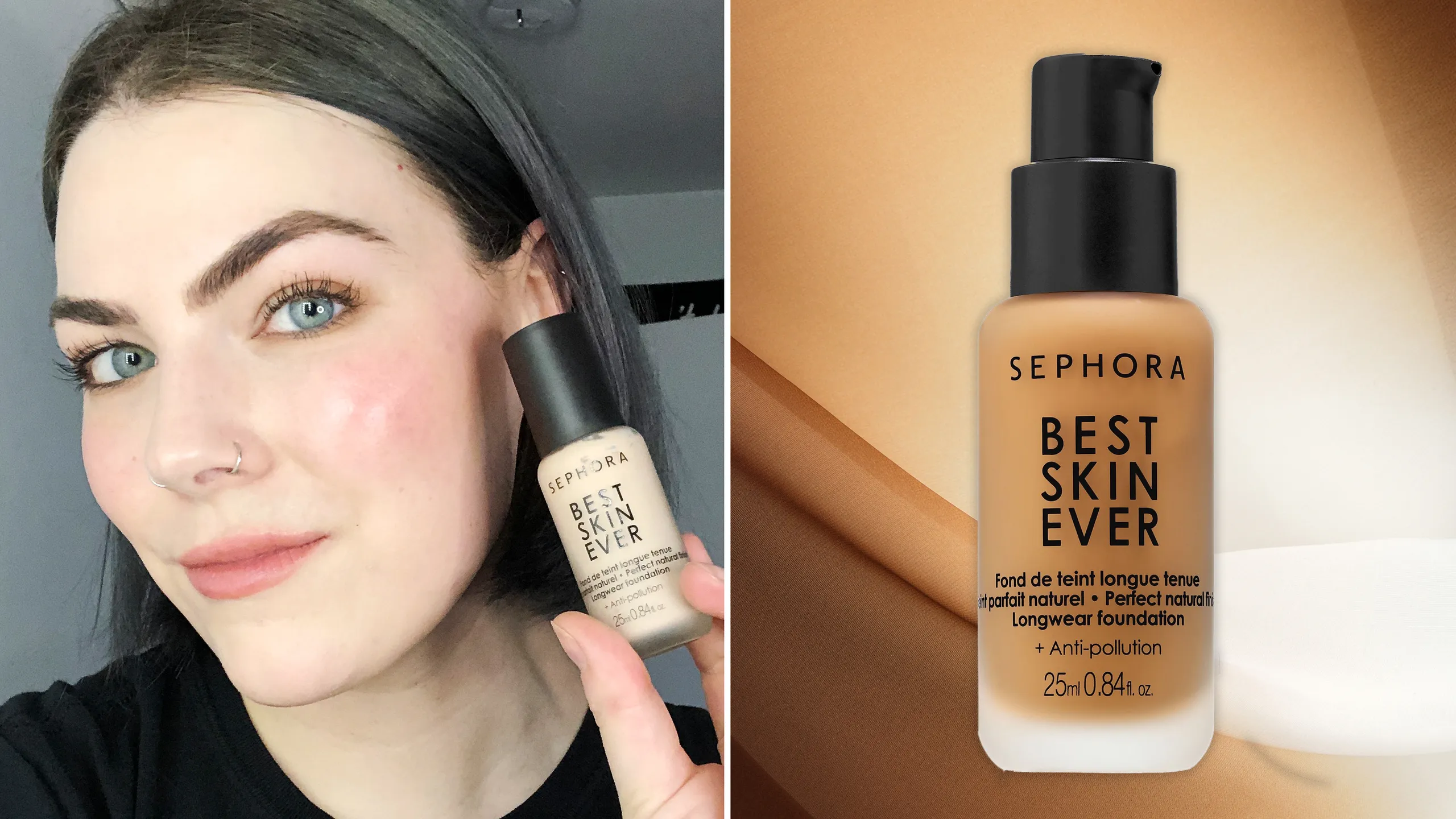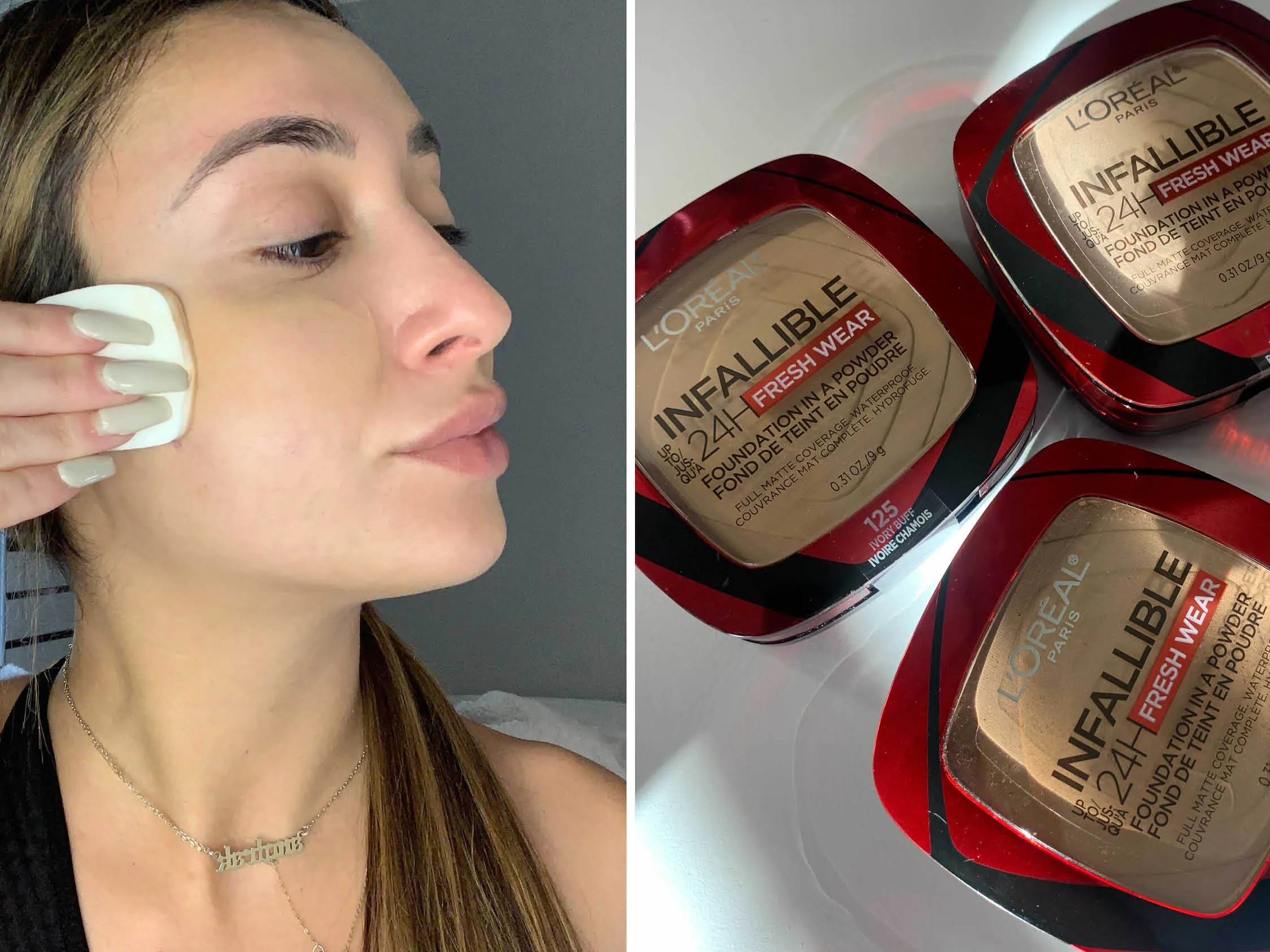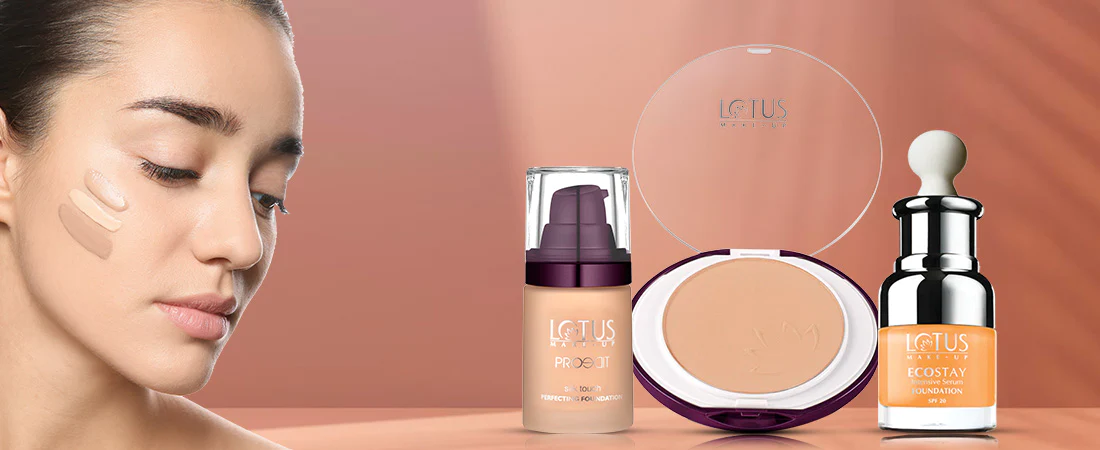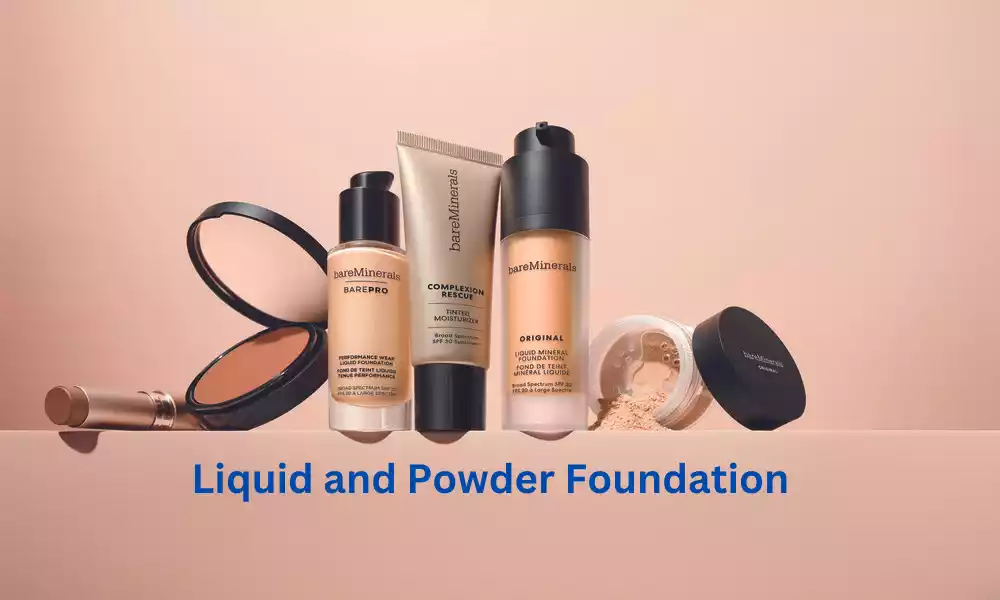Liquid and Powder Foundation are two popular types of cosmetics used to achieve a flawless complexion. Liquid foundation is a versatile product that comes in a liquid form, offering a wide range of coverage options from light to full. It is known for its ability to provide a smooth and natural finish, making it suitable for various skin types. On the other hand, powder foundation comes in compact or loose powder form and is renowned for its matte finish, making it ideal for controlling shine and oiliness.
Powder foundation is often favored by those with oily or combination skin and provides lightweight, subtle coverage. Both liquid and powder foundations are essential tools in the world of makeup, allowing individuals to enhance their skin’s appearance and achieve the desired level of coverage and finish.
Definition of Liquid Foundation
Liquid foundation is a cosmetic product designed to even out the complexion and provide a smooth base for other makeup. It comes in a liquid form, typically housed in a bottle or tube, and can be easily spread across the face using various application methods like brushes, sponges, or fingertips. Liquid foundation is known for its versatility; it offers a range of coverage options, from sheer to full, and is available in various finishes such as matte, dewy, and natural.

The formulation often includes various ingredients like pigments for color, emollients for a smooth texture, and sometimes additional components like SPF, moisturizers, or skin-nourishing vitamins. It is particularly favored for its ability to blend seamlessly into the skin, offering a more “skin-like” appearance when applied correctly.
Definition of Powder Foundation
Powder foundation is a cosmetic product formulated to provide a uniform complexion and serve as a base layer for other makeup. Unlike its liquid counterpart, it comes in a solid, powder form that is usually compacted into a pan and housed in a compact case. Powder foundations can be applied with a variety of tools, such as brushes or puffs, and are known for their quick and easy application.

They offer varying levels of coverage, generally ranging from light to medium, and often provide a matte or semi-matte finish. The formulation typically includes mineral or talc-based ingredients, along with pigments for color, and may also contain additional elements like SPF or oil-absorbing particles. Powder foundation is popular among individuals with oily or combination skin due to its ability to control shine and provide a long-lasting finish.
Comparison Table of Liquid and Powder Foundation
| Feature | Liquid Foundation | Powder Foundation |
|---|---|---|
| Texture and Consistency | Creamy and smooth | Dry and powdery |
| Application Method | Brushes, sponges, fingertips | Brushes, puffs |
| Coverage | Sheer to full | Light to medium |
| Longevity and Durability | Moderate to long-lasting; may require setting | Generally long-lasting; less likely to require setting |
| Suitability for Skin Types | All types; best for dry, normal, combination | Oily, combination, sensitive |
| Finish | Matte, dewy, natural | Matte, semi-matte |
| Ingredients | Emollients, pigments, SPF, vitamins | Minerals, talc, pigments, SPF |
| Portability and Convenience | Less portable; may require additional tools | More portable; often comes with built-in mirror and puff |
| Pros | Versatile, buildable, wide range of shades | Quick application, controls shine, less likely to oxidize |
| Cons | May require setting, can feel heavy, potential for oxidation | Can emphasize dry patches, less buildable, can look cakey if overapplied |
| Popular for | Photography, professional makeup, special events | Everyday use, quick touch-ups, athletic activities |
| Shade Range | Typically extensive | Usually less extensive |
This table serves as a quick reference to the key differences between liquid and powder foundations, offering insights that can help you make an informed choice based on your needs and skin type.
Pros and Cons of Liquid Foundation
Pros:
- Versatility: Liquid foundation is available in a wide variety of formulations, allowing it to cater to different skin types and preferences.
- Buildable Coverage: Offers a range of coverage from sheer to full, which can be easily built up or sheered out according to individual needs.
- Variety of Finishes: Comes in multiple finishes including matte, dewy, and natural, providing more options to achieve the desired look.
- Blends Seamlessly: The liquid consistency helps it blend easily into the skin, creating a more natural, “skin-like” finish.
- Hydrating Options: Many liquid foundations contain moisturizing ingredients that can be beneficial for dry or mature skin.
- Wide Shade Range: Typically offers an extensive array of shades, making it easier to find a match for various skin tones.
- Additional Benefits: Formulas often include extra features such as SPF, antioxidants, and skin-nourishing vitamins.
- Photography-Friendly: High-quality liquid foundations tend to photograph well, making them a popular choice for professional settings and special events.
Cons:
- May Require Setting: Liquid foundation often requires a setting powder or spray to extend its wear time.
- Potential for Oxidation: Some formulas can darken or change color when exposed to air, making it crucial to test before committing.
- Can Feel Heavy: Depending on the formulation and amount used, it can sometimes feel heavy or greasy on the skin.
- Less Portable: Bottles and tubes are generally less convenient to carry around for touch-ups compared to compact powder foundations.
- Risk of Caking: Overapplication or layering with other creamy products can result in a cakey appearance.
- May Not Control Oil: Those with oily skin may find that liquid foundation doesn’t adequately control shine throughout the day.
- Can Be Expensive: High-end liquid foundations can be costly, especially those with added skincare benefits or advanced formulations.
- Application Time: Proper blending and layering can be more time-consuming compared to applying powder foundation.
Understanding these pros and cons can help you make an informed decision about whether liquid foundation is the right choice for your makeup routine.
Pros and Cons of Powder Foundation
Pros:
- Quick Application: The dry, solid form allows for faster and simpler application, making it ideal for on-the-go or last-minute touch-ups.
- Oil Control: Powder foundations often have oil-absorbing properties, making them suitable for oily and combination skin types.
- Long-lasting: Typically provides a long-wearing finish that is less likely to require setting, especially beneficial for oily skin types.
- Portable: Comes in a compact case, often with a built-in mirror and applicator, making it convenient for travel and quick touch-ups.
- Less Risk of Oxidation: Unlike liquid foundations, powder foundations are less likely to change color when exposed to air.
- Natural Matte Finish: Usually offers a matte or semi-matte finish that looks natural and is less likely to feel heavy on the skin.
- Low Risk of Contamination: The solid form is less prone to bacterial growth compared to liquid formulations.
- Less Irritating: Formulations are often simpler and may be less irritating for sensitive skin types; many are mineral-based.
Cons:
- Limited Coverage: Generally offers light to medium coverage and is not as easily buildable for fuller coverage.
- Can Emphasize Dryness: The matte finish can accentuate dry patches, fine lines, and wrinkles, making it less ideal for dry or mature skin.
- Less Shade Range: Often comes in fewer shades compared to liquid foundations, making it more challenging to find an exact match.
- Risk of Cakiness: If overapplied, powder foundation can look cakey and unnatural.
- Limited Finishes: Generally comes in fewer finish options, mostly matte and semi-matte, offering less versatility.
- Incompatibility with Liquid Products: May not blend well with liquid or cream products like concealers or cream blushes.
- May Lack Additional Benefits: Less likely to contain added skincare ingredients like SPF, antioxidants, or hydrating agents.
- Can Settle into Pores: Some formulations can settle into pores or fine lines, especially if not properly blended.
Knowing these pros and cons can help you decide whether powder foundation is the right choice for your specific needs and skin type.
Choosing the Right Foundation for Your Skin Type
Selecting the right foundation is crucial for achieving a flawless makeup look, and your skin type plays a significant role in this decision.

Here’s a guide to help you choose the ideal foundation based on your skin type.
Dry Skin
- Best Choice: Liquid Foundation
- Why: Liquid foundations often contain hydrating ingredients and offer a dewy finish, providing the moisture that dry skin needs.
- Ingredients to Look For: Hyaluronic acid, glycerin, and natural oils.
- Avoid: Matte finish foundations and powder foundations, as they can emphasize dry patches.
Normal Skin
- Best Choice: Either Liquid or Powder
- Why: Normal skin is versatile and can handle most types of foundation.
- Ingredients to Look For: SPF for daytime wear, antioxidants.
- Avoid: Extremely matte or dewy finishes, unless that’s the specific look you’re going for.
Oily Skin
- Best Choice: Powder Foundation
- Why: Powder foundations are good at absorbing excess oil, offering a matte finish that can help control shine.
- Ingredients to Look For: Salicylic acid, oil-absorbing minerals.
- Avoid: Foundations with a dewy or luminous finish, as they can make skin appear even oilier.
Combination Skin
- Best Choice: Both Liquid and Powder (for different zones)
- Why: Use liquid foundation on dry areas and powder foundation on oily areas to balance out your skin.
- Ingredients to Look For: Oil-free formulas, mattifying ingredients for the T-zone.
- Avoid: Full-coverage foundations can look uneven on combination skin; opt for medium coverage instead.
Sensitive Skin
- Best Choice: Mineral Powder Foundation
- Why: Mineral foundations are less likely to irritate sensitive skin.
- Ingredients to Look For: Titanium dioxide, zinc oxide, simple ingredient lists.
- Avoid: Fragrances, parabens, and other potential irritants.
Mature Skin
- Best Choice: Liquid Foundation with a Natural Finish
- Why: Liquid foundation can be more hydrating and less likely to settle into fine lines.
- Ingredients to Look For: Anti-aging ingredients like peptides, antioxidants.
- Avoid: Heavy, full-coverage foundations that can make skin look cakey or settled.
Tips for All Skin Types:
- Shade Matching: Always test foundation shades in natural light and let them settle for a few minutes to check for oxidation.
- Patch Test: Particularly for sensitive skin, it’s important to patch-test a new foundation to check for any allergic reactions.
- Consult a Professional: If you’re still uncertain, consulting with a makeup artist or dermatologist can provide personalized advice.
By understanding your skin type and what each type of foundation offers, you can make a more informed choice for a picture-perfect look.
Application Techniques
Applying foundation correctly can significantly impact its finish, coverage, and longevity. Here are some common application techniques for both liquid and powder foundation:
Liquid Foundation
- Fingertips:
- Technique: Dot foundation on your face and blend outwards.
- Best For: Light coverage, quick application.
- Tips: Warm the foundation between your fingers to help it blend more easily.
- Flat Foundation Brush:
- Technique: Use broad strokes to apply and blend.
- Best For: Medium coverage.
- Tips: Use downward strokes to lay the foundation, following the direction of facial hair.
- Buffing Brush:
- Technique: Buff foundation into the skin in circular motions.
- Best For: Medium to full coverage.
- Tips: Start from the center of the face and work outwards for a seamless blend.
- Beauty Sponge:
- Technique: Dampen the sponge and bounce it over the skin to blend.
- Best For: Natural, airbrushed finish.
- Tips: Use the pointed end for hard-to-reach areas like under the eyes and around the nose.
- Airbrush:
- Technique: Spray foundation using an airbrush machine.
- Best For: Professional, full coverage.
- Tips: Keep the nozzle at least six inches away from the face for even application.
Powder Foundation
- Kabuki Brush:
- Technique: Use circular motions to buff the powder into the skin.
- Best For: Light to medium coverage.
- Tips: Tap off excess product to avoid overapplication.
- Powder Puff:
- Technique: Press and roll the puff onto the skin.
- Best For: Medium coverage.
- Tips: Fold the puff for precision application around the nose and eyes.
- Dense Flat-top Brush:
- Technique: Press the brush into the powder, then onto the skin.
- Best For: Medium to full coverage.
- Tips: Use a stippling motion for more coverage.
- Sponge:
- Technique: Use a dry or slightly damp sponge to press the product into the skin.
- Best For: Full coverage.
- Tips: A damp sponge can offer a slightly dewier finish.
- Layering:
- Technique: Apply a light layer of powder over liquid foundation.
- Best For: Additional coverage and setting.
- Tips: Use a large, fluffy brush for a light application to set liquid foundation.
General Tips:
- Primer: Start with a primer suited to your skin type for better adhesion and longevity.
- Setting: Use setting spray for liquid foundation and setting powder for powder foundation, if needed.
- Skin Prep: Always start with a clean, moisturized face for the best results.
Each application technique has its own set of benefits, so you may want to experiment to see which works best for you.
Top Brands to Consider
Whether you prefer liquid or powder foundation, several well-known brands cater to various skin types and tones. Here are some top picks to consider:
Liquid Foundation Brands
- Estée Lauder
- Best For: Long-lasting coverage
- Popular Product: Double Wear Stay-in-Place Makeup
- Giorgio Armani
- Best For: Luxurious, lightweight feel
- Popular Product: Luminous Silk Foundation
- MAC Cosmetics
- Best For: Wide shade range
- Popular Product: Studio Fix Fluid SPF 15
- Maybelline
- Best For: Budget-friendly options
- Popular Product: Fit Me Matte + Poreless Foundation
- Fenty Beauty by Rihanna
- Best For: Inclusivity and diverse shade range
- Popular Product: Pro Filt’r Soft Matte Longwear Foundation
Powder Foundation Brands
- BareMinerals
- Best For: Natural, mineral-based formulas
- Popular Product: Original Loose Powder Mineral Foundation
- Laura Mercier
- Best For: Fine-milled powder for a natural look
- Popular Product: Smooth Finish Foundation Powder
- MAC Cosmetics
- Best For: Buildable coverage
- Popular Product: Studio Fix Powder Plus Foundation
- L’Oréal Paris
- Best For: Drugstore quality
- Popular Product: True Match Powder
- Bobbi Brown
- Best For: A skin-like finish
- Popular Product: Skin Weightless Powder Foundation
Tips for Choosing a Brand
- Test Samples: Always try to sample the product before making a full purchase to ensure it suits your skin type and tone.
- Check Reviews: Look for reviews from people who have similar skin concerns to get an idea of how the product performs.
- Consult Professionals: If possible, consult a makeup artist or dermatologist for personalized advice.
- Check for Additional Features: Look for foundations that offer added benefits like SPF, hydrating ingredients, or long-wearing capabilities.
- Cruelty-Free or Vegan: If this is important to you, look for brands that are certified cruelty-free or offer vegan formulas.
Choosing the right foundation brand can make a significant difference in your makeup routine, so it’s worth taking the time to research and find the best fit for your needs.
Final Thoughts
The choice between liquid and powder foundation largely depends on your skin type, lifestyle, and the kind of coverage you’re looking for. Liquid foundation offers versatility and a range of finishes but may require touch-ups, while powder foundation is great for longevity and controlling oil but can be limited in terms of coverage. Ultimately, it’s all about understanding your skin’s specific needs and experimenting to find the perfect fit for you.



